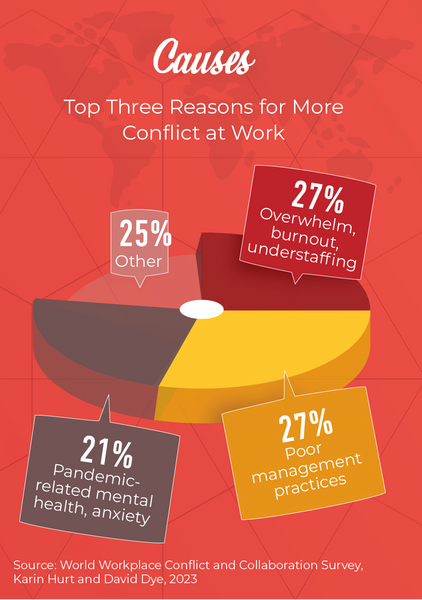Talent Development Leader
Navigating Productive Workplace Conflict
Turn tensions into triumphs with tips distilled from recent survey data.
Mon Mar 25 2024

During the past few years, the workforce has been through unprecedented changes that directly contribute to the higher rates and nature of conflict. Workplace conflict isn’t new, but we wanted to examine modern workplace conflict by conducting the World Workplace Conflict and Collaboration Survey, which included more than 5,000 full-time workers in more than 45 countries.
Why conflict is getting harder
In the survey, 70 percent of employees reported experiencing the same or more conflict than just a few years ago. When we asked respondents to identify the top three reasons for the conflict, several issues rose to the surface.

First, the pandemic has cast a long shadow that has affected workplace conflict. For many, hypervigilance, anxiety, social isolation, and stress from COVID-19 created lasting mental health challenges. For others, the resentment of mandates and loss of personal freedoms created another kind of fear and anxiety. Take the increase in anxiety, stress, and depression, mix in the loss of human relationships, and the result is a potent conflict cocktail that spills over into the workplace for both learners and stakeholders.
Second, overwhelm, burnout, and staffing challenges continue to plague many workplaces. Organizations continue to wrestle with the new reality of remote and hybrid workforces.
Third, managers are relearning how to lead and support their teams. Teammates are figuring out how to build meaningful relationships and get work done. Those rapid changes and missed human connections also fuel workplace conflict and make it harder to solve.
The 4 Cs
We also asked survey participants about major conflicts in their professional lives and what advice they would give themselves if they could go back in time. Their top answers, “Be patient/stay calm” and “Talk about it,” offer wisdom for every L&D leader navigating conflict with learners, sponsors, and challenging stakeholders. But how exactly do you achieve that state of mind? What is it you talk about?

Conflict doesn’t have to be a destructive force. Transform potentially damaging disagreements into constructive dialogue and help create a patient and calm mindset by focusing on four critical dimensions of collaboration: connection, clarity, curiosity, and commitment.
Connection. Do we know one another as human beings? Workplace conflict always involves people—and every conflict gets easier the more you know one another, understand each other’s perspectives, and see each other as human beings. Fostering connections is more powerful than simple professional interactions. It’s about understanding the motivations, backgrounds, and aspirations of every team member and stakeholder.
Do you know their people, pets, or personal projects? If you have a team member who volunteers to assist children in poverty, you could address disagreements about training content with an understanding of their strong inclination toward accessibility and inclusivity. The more connection you can build before you need it, the easier conflict becomes.
Sample phrases to use include:
“I care about this project, and I’m confident we can find a solution that will work.”
“Tell me more.”
Clarity. Do we have a shared understanding of success? Clarity is the bedrock of collaboration. A clear, shared vision prevents a multitude of destructive conflicts and enables you to choose a path with the best likelihood of success.
Focus on learning outcomes, how behaviors will be different, and tangible business results. That will ensure all stakeholders have a tangible grasp of the project’s goals, regardless of their level of familiarity with L&D terminology.
Sample phrases to use include:
“What would a successful outcome do for you?”
“Let’s start with what we agree on.”
Curiosity. Are we genuinely interested in other perspectives and possibilities? A hallmark of dynamic L&D leaders is their unrelenting curiosity. By genuinely valuing and seeking diverse perspectives, you pave the way for innovation.
For example, when a stakeholder critiques a training module, instead of getting defensive, ask probing questions to understand why. Your sincere curiosity helps people to feel seen, gives you a better understanding of what it will take to solve a problem, and often leads to innovative solutions that merge different viewpoints.
Sample phrases to use include:
“I’m curious—how does the issue look from your perspective?”
“What do you suggest we do next?”
Commitment. Do we have a clear agreement? This final dimension is the glue that binds the team and the project. It’s an unwavering dedication to the shared objective and to each other. Crafting a project charter at the onset as well as outlining roles, responsibilities, and the collective vision ensures everyone is on the same page, mitigating potential rifts down the line.
Sample phrases to use include:
“To recap our conversation, we’ve agreed to \[repeat agreement\]. Is that your understanding?”
“Let’s schedule time to discuss how our solution is working.”

How to apply the 4 Cs
Being familiar with the 4 Cs is one thing; integrating them into your daily leadership practice is another.
Imagine a situation where a department head believes a training module is overly technical, while your team believes its depth is necessary. Using the 4Cs, you connect with the department head by referencing their initial industry struggles, seeking clarity on how to balance depth with accessibility, expressing genuine curiosity about their take on solutions, and, finally, revisiting the project charter to ensure alignment.
Here are specific powerful phrases to achieve each of your goals.
Connection. “You previously mentioned your initial struggles when entering this industry. Can you tell me more about what would have helped you as a newcomer so we can balance that with technical depth?”
Clarity. “In our initial vision for this module, we agreed on a deep dive into the subject. I also hear a desire to support newcomers. What outcomes would a successful balance between depth and accessibility achieve?”
Curiosity. “What’s your take on conducting an intake audit of new employees’ industry experience before they begin the program?”
Commitment. “For next steps, let’s do a participant pulse survey two weeks into the program. I’m sending you a meeting invitation so we can review how the approach is working.”
Transform tension to triumph for a lasting difference
As the L&D landscape continues to evolve, the workplace becomes more complex, and as learner needs multiply, conflicts are inevitable. But when you invest in the 4 Cs, you’ll not only navigate challenges; you’ll harness them to fuel transformative growth and innovation.
Mastering productive conflict will ensure your work makes a lasting difference for your learners and organization alike.
Read more from Talent Development Leader.
